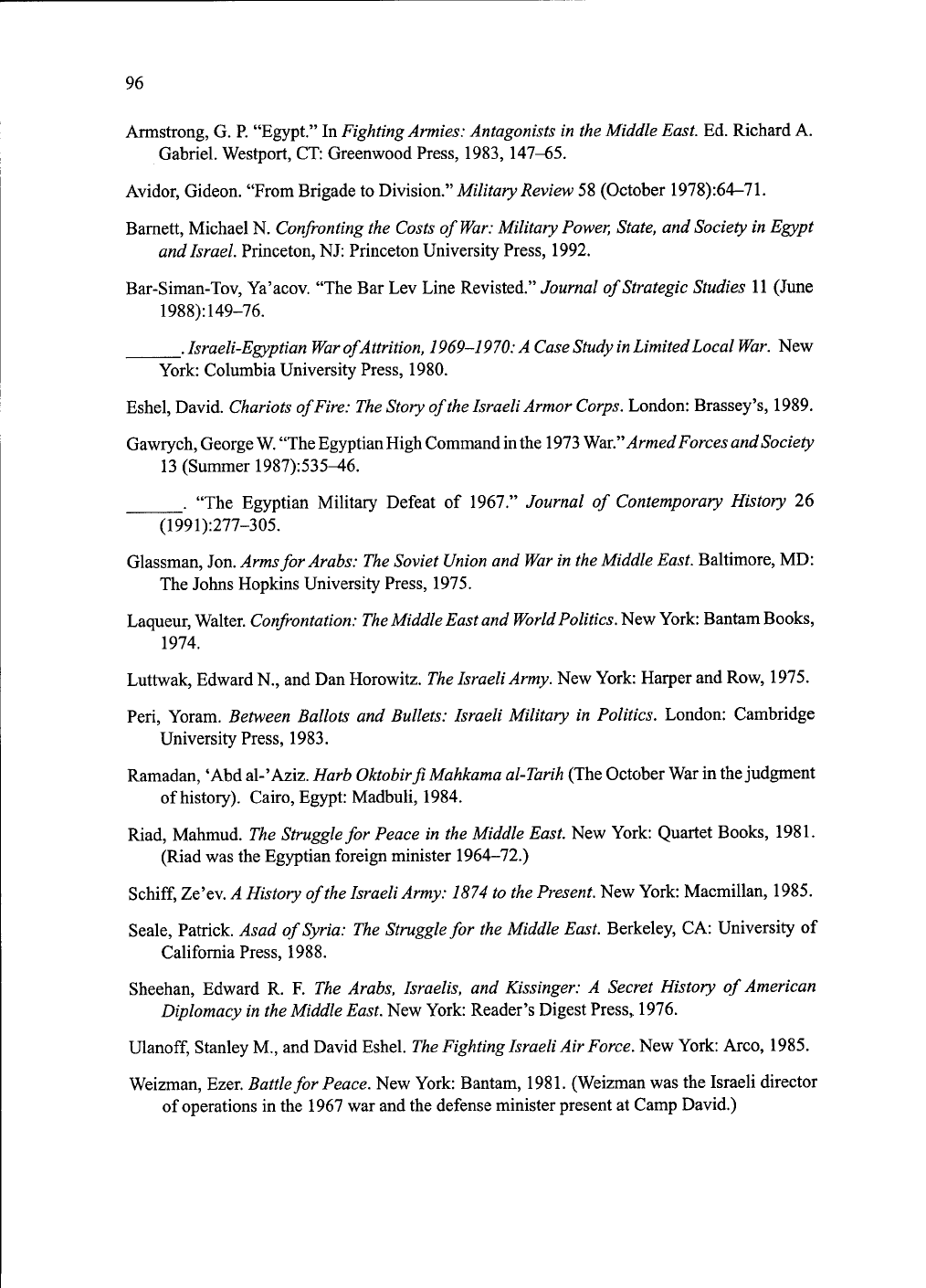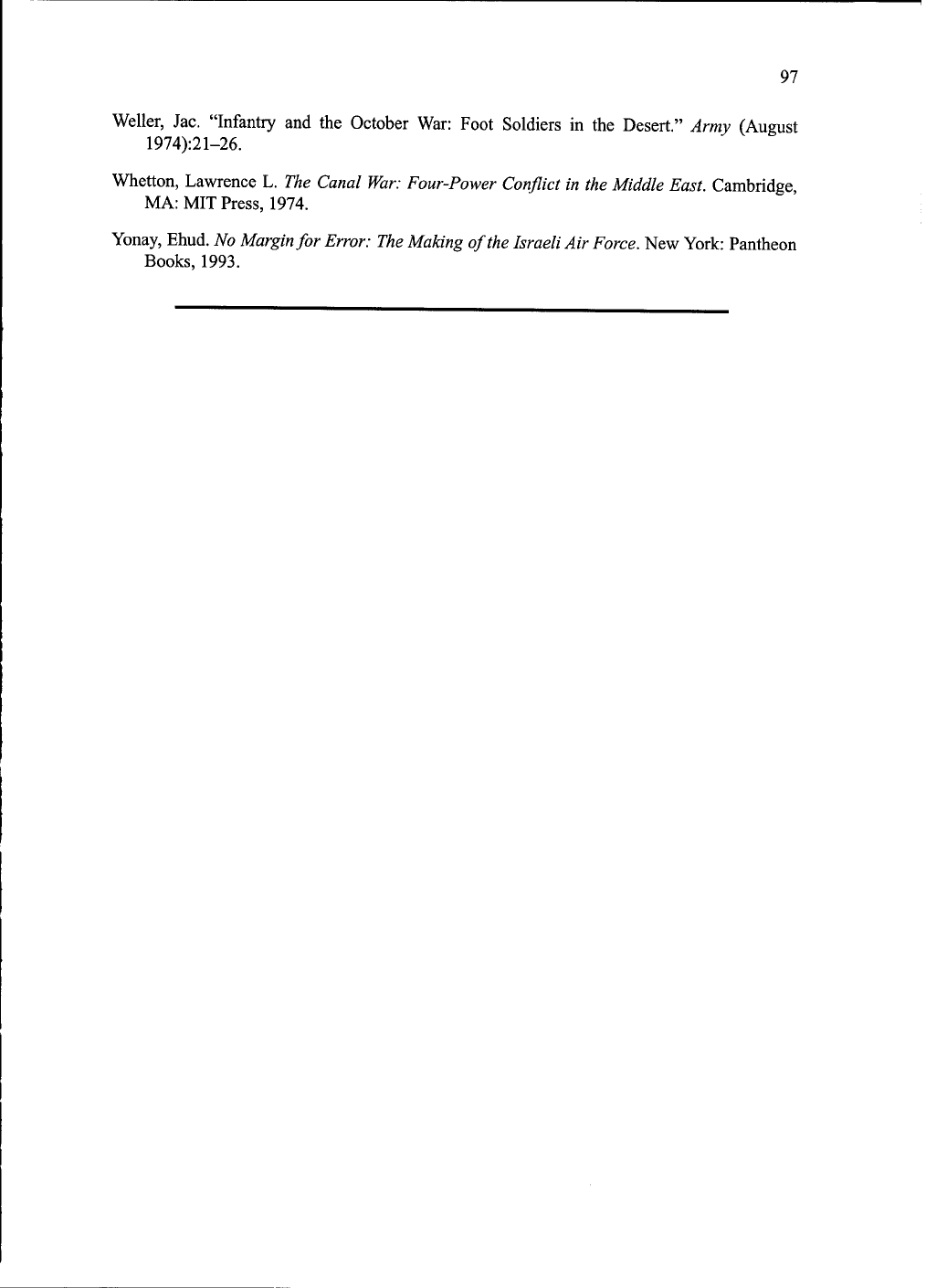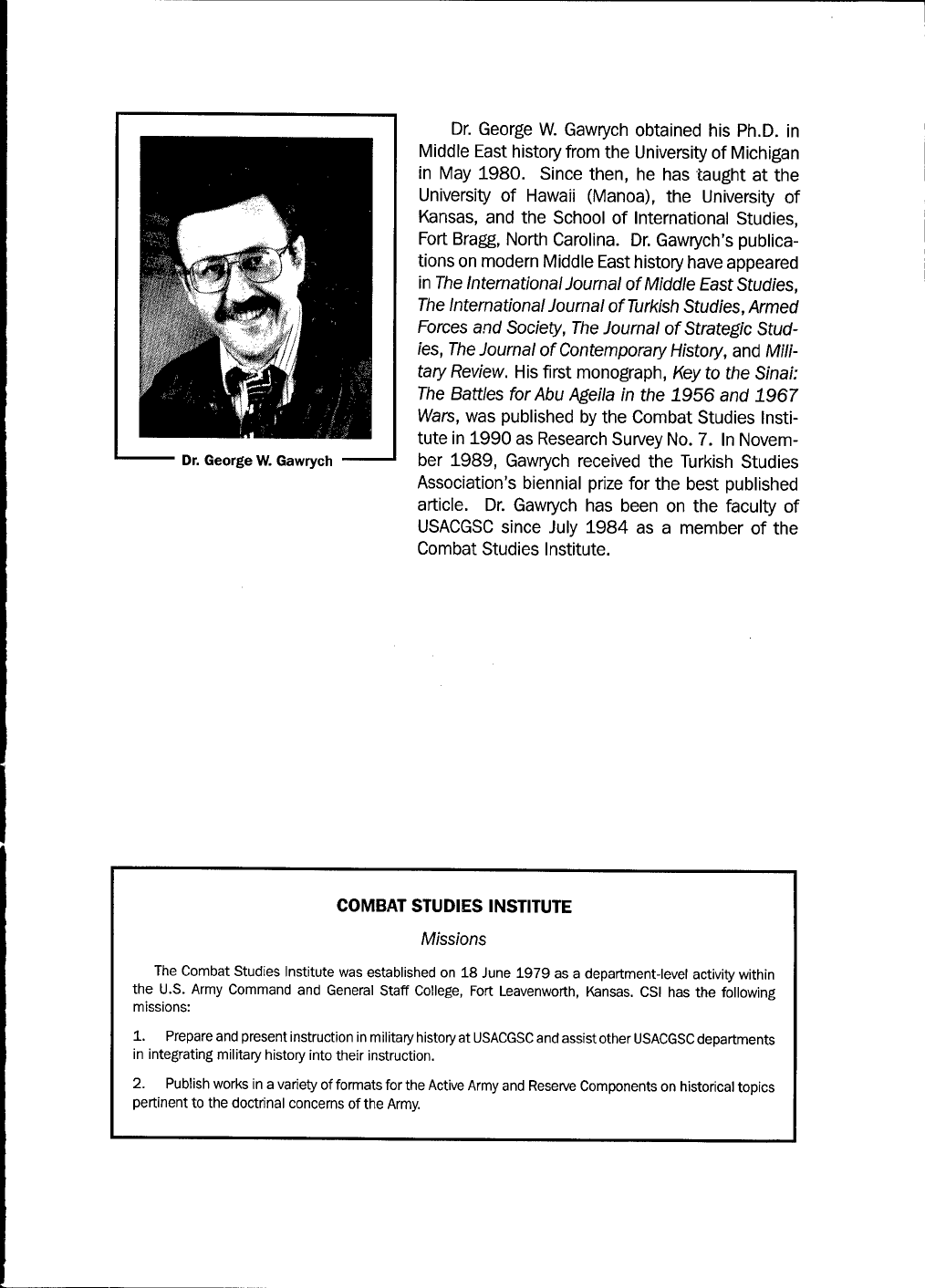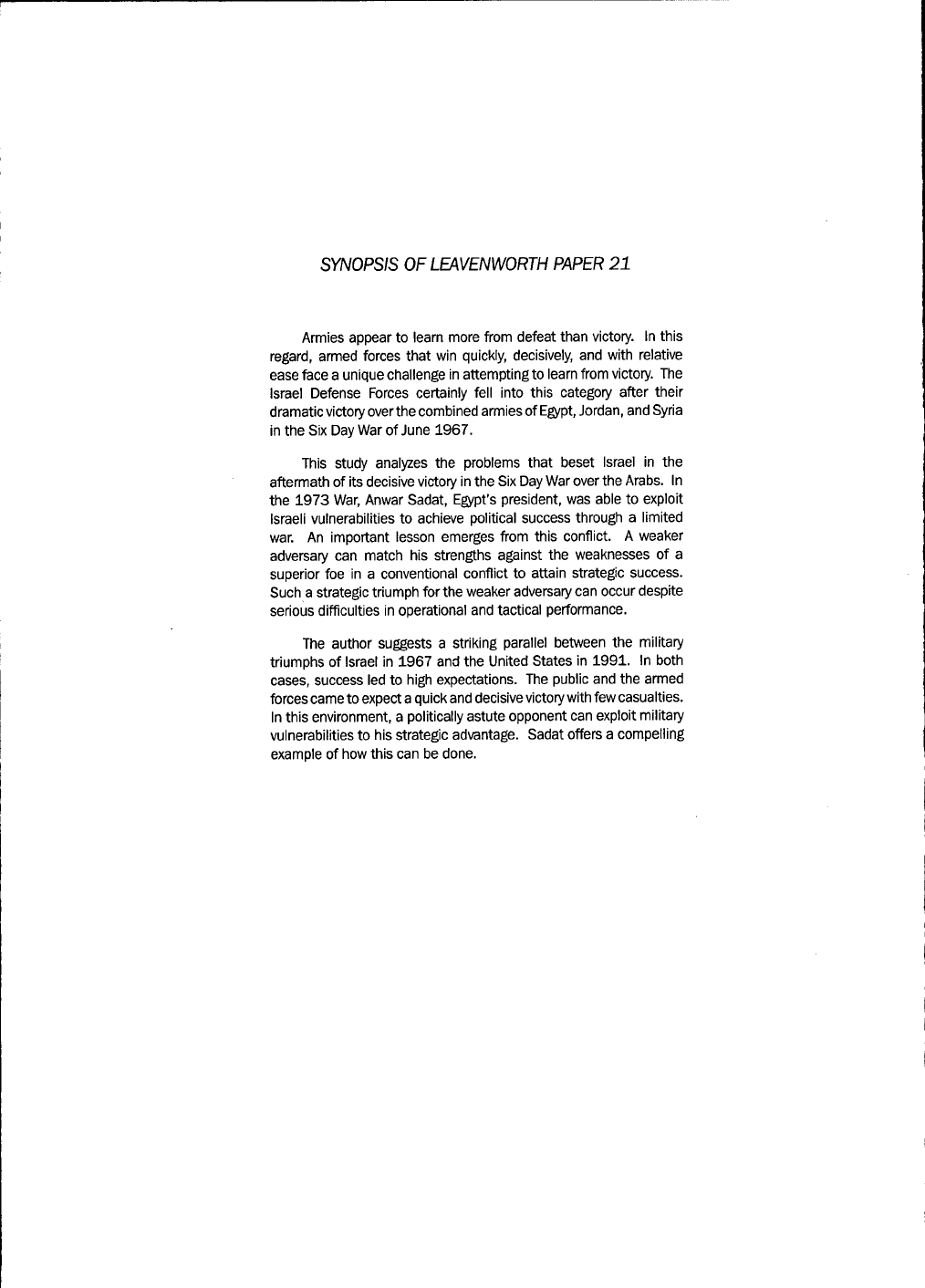Gawrych George W. The 1973 Arab-Israeli War: The Albatross of Decisive Victory (Leavenworth Papers No.21)
Подождите немного. Документ загружается.


96
Armstrong,
G.
P.
"Egypt."
In
Fighting
Armies:
Antagonists
in
the
Middle
East.
Ed.
Richard
A.
Gabriel.
Westport,
CT:
Greenwood
Press,
1983,
147-65.
Avidor,
Gideon.
"From
Brigade
to
Division."
Military
Review
58
(October
1978):64—71.
Barnett,
Michael
N.
Confronting
the
Costs
of
War:
Military
Power,
State,
and
Society
in
Egypt
and
Israel.
Princeton,
NJ:
Princeton
University
Press,
1992.
Bar-Siman-Tov,
Ya'acov.
"The
Bar
Lev
Line
Revisted."
Journal
of
Strategic
Studies
11
(June
1988):149-76.
.
Israeli-Egyptian
War
of
Attrition,
1969-1970:
A
Case
Study
in
Limited
Local
War.
New
York:
Columbia
University
Press,
1980.
Eshel,
David.
Chariots
of
Fire:
The
Story
of
the
Israeli
Armor
Corps.
London:
Brassey's,
1989.
Gawrych,
George
W.
"The
Egyptian
High
Command
in
the
1973
Wax."
Armed
Forces
and
Society
13
(Summer
1987):535^6.
.
"The
Egyptian
Military
Defeat
of
1967."
Journal
of
Contemporary
History
26
(1991):277-305.
Glassman,
Jon.
Arms
for
Arabs:
The
Soviet
Union
and
War
in
the
Middle
East.
Baltimore,
MD:
The
Johns
Hopkins
University
Press,
1975.
Laqueur,
Walter.
Confrontation:
The
Middle
East
and
World
Politics.
New
York:
Bantam
Books,
1974.
Luttwak,
Edward
N.,
and
Dan
Horowitz.
The
Israeli
Army.
New
York:
Harper
and
Row,
1975.
Peri,
Yoram.
Between
Ballots
and
Bullets:
Israeli
Military
in
Politics.
London:
Cambridge
University
Press,
1983.
Ramadan,
'Abd
al-'Aziz.
Harb
Oktobirfi
Mahkama
al-Tarih
(The
October
War
in
the
judgment
of
history).
Cairo,
Egypt:
Madbuli,
1984.
Riad,
Mahmud.
The
Struggle
for
Peace
in
the
Middle
East.
New
York:
Quartet
Books,
1981.
(Riad
was
the
Egyptian
foreign
minister
1964-72.)
Schiff,
Ze'ev.
A
History
of
the
Israeli
Army:
1874
to
the
Present.
New
York:
Macmillan,
1985.
Seale,
Patrick.
Asad
of
Syria:
The
Struggle
for
the
Middle
East.
Berkeley,
CA:
University
of
California
Press,
1988.
Sheehan,
Edward
R.
F.
The
Arabs,
Israelis,
and
Kissinger:
A
Secret
History
of
American
Diplomacy
in
the
Middle
East.
New
York:
Reader's
Digest
Press,
1976.
Ulanoff,
Stanley
M.,
and
David
Eshel.
The
Fighting
Israeli
Air
Force.
New
York:
Arco,
1985.
Weizman,
Ezer.
Battle
for
Peace.
New
York:
Bantam,
1981.
(Weizman
was
the
Israeli
director
of
operations
in
the
1967
war
and
the
defense
minister
present
at
Camp
David.)

97
Weller,
Jac.
"Infantry
and
the
October
War:
Foot
Soldiers
in
the
Desert."
Army
(August
1974):21-26.
Whetton,
Lawrence
L.
The
Canal
War:
Four-Power
Conflict
in
the
Middle
East.
Cambridge,
MA:
MIT
Press,
1974.
Yonay,
Ehud.
No
Margin
for
Error:
The
Making
of
the
Israeli
Air
Force.
New
York:
Pantheon
Books,
1993.

Dr.
George
W.
Gawrych
Dr.
George
W.
Gawrych
obtained
his
Ph.D.
in
Middle
East
history
from
the
University
of
Michigan
in
May
1980.
Since
then,
he
has
taught
at
the
University
of
Hawaii
(Manoa),
the
University
of
Kansas,
and
the
School
of
International
Studies,
Fort
Bragg,
North
Carolina.
Dr.
Gawrych's
publica-
tions
on
modern
Middle
East
history
have
appeared
in
The
International
Journal
of
Middle
East
Studies,
The
IntemationalJournal
of
Turkish
Studies,
Armed
Forces
and
Society,
The
Journal
of
Strategic
Stud-
ies,
The
Journal
of
Contemporary
History,
and
Mili-
tary
Review.
His
first
monograph,
Key
to
the
Sinai:
The
Battles
for
Abu
Ageila
in
the
1956
and
1967
Wars,
was
published
by
the
Combat
Studies
Insti-
tute
in
1990
as
Research
Survey
No.
7.
In
Novem-
ber
1989,
Gawrych
received
the
Turkish
Studies
Association's
biennial
prize
for
the
best
published
article.
Dr.
Gawrych
has
been
on
the
faculty
of
USACGSC
since
July
1984
as
a
member
of
the
Combat
Studies
Institute.
COMBAT
STUDIES
INSTITUTE
Missions
The
Combat
Studies
Institute
was
established
on
18
June
1979
as
a
department-level
activity
within
the
U.S.
Army
Command
and
General
Staff
College,
Fort
Leavenworth,
Kansas.
CSI
has
the
following
missions:
1.
Prepare
and
present
instruction
in
military
history
at
USACGSC
and
assist
other
USACGSC
departments
in
integrating
military
history
into
their
instruction.
2.
Publish
works
in
a
variety
of
formats
for
the
Active
Army
and
Reserve
Components
on
historical
topics
pertinent
to
the
doctrinal
concerns
of
the
Army.

SYNOPSIS
OF
LEAVENWORTH
PAPER
21
Armies
appear
to
learn
more
from
defeat
than
victory.
In
this
regard,
armed
forces
that
win
quickly,
decisively,
and
with
relative
ease
face
a
unique
challenge
in
attempting
to
learn
from
victory.
The
Israel
Defense
Forces
certainly
fell
into
this
category
after
their
dramatic
victory
over
the
combined
armies
of
Egypt,
Jordan,
and
Syria
in
the
Six
Day
War
of
June
1967.
This
study
analyzes
the
problems
that
beset
Israel
in
the
aftermath
of
its
decisive
victory
in
the
Six
Day
War
over
the
Arabs.
In
the
1973
War,
Anwar
Sadat,
Egypt's
president,
was
able
to
exploit
Israeli
vulnerabilities
to
achieve
political
success
through
a
limited
war.
An
important
lesson
emerges
from
this
conflict.
A
weaker
adversary
can
match
his
strengths
against
the
weaknesses
of
a
superior
foe
in
a
conventional
conflict
to
attain
strategic
success.
Such
a
strategic
triumph
for
the
weaker
adversary
can
occur
despite
serious
difficulties
in
operational
and
tactical
performance.
The
author
suggests
a
striking
parallel
between
the
military
triumphs
of
Israel
in
1967
and
the
United
States
in
1991.
In
both
cases,
success
led
to
high
expectations.
The
public
and
the
armed
forces
came
to
expect
a
quick
and
decisive
victory
with
few
casualties.
In
this
environment,
a
politically
astute
opponent
can
exploit
military
vulnerabilities
to
his
strategic
advantage.
Sadat
offers
a
compelling
example
of
how
this
can
be
done.
